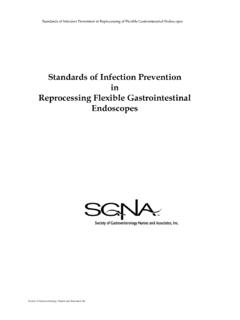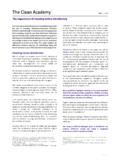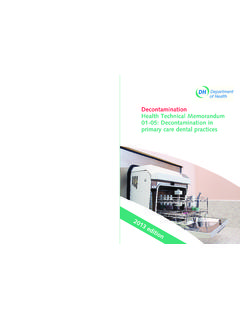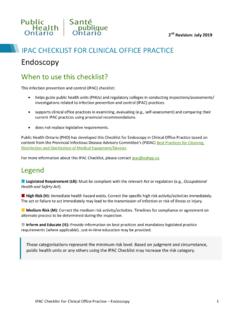Transcription of National Guidelines on Visual Inspection of Flexible ...
1 ANSI/AAMI, AORN, IAHCSMM, SGNA & CDC Guidelines on Visual Inspection Flexible endoscopes ANSI/AAMI ST91: 2015 Flexible and semi-rigid endoscope processing in health care facilities states in : Tools such as video borescopes of an appropriate dimension (length and diameter) may be used to visually inspect the internal channels of some medical devices. 2017 Edition AORN Guidelines for perioperative Practices - Flexible endoscopes Recommendations VII Flexible endoscopes accessories and associated equipment should be visually inspected for cleanliness, integrity, and function before use, during the procedure, after the procedure, after cleaning and before disinfection or sterilization. Lighted magnification should be used to inspect endoscopes and accessories for cleanliness and damage.
2 65 [2: High Evidence] An endoscope that appears clean may harbor debris that cannot be seen without magnification. Lighted magnification may increase the ability to identify residual soil or damage. Internal Channels of Flexible endoscopes may be inspected using an endoscopic camera or borescope. [2: High evidence] Endoscopic cameras and borescopes penetrate the lumen and allow for improved Visual Inspection . IAHCSMM Endoscope Reprocessing Manual, 2017 The most important areas for Inspection are the lumens that run through the endoscope. Lumens pose a cleaning challenge because of their narrow structure that prevents visualization during the cleaning; therefore, it is important to always check lumens for cleanliness after cleaning.
3 Visual Inspection of lumens can be accomplished using a borescope, a small Flexible fiberoptic device that enables visualization of otherwise inaccessible areas within endoscope lumens. SGNA s 2016 Standards of Infection Prevention in Reprocessing of Flexible Gastrointestinal endoscopes states: Visual Inspection is recommended to make sure the endoscope is visibly clean (AAMI, 2015; Rutala et al., 2008). It is not a guarantee that decontamination from manual cleaning is complete, but it can be considered a safety stop or time out to ensure the endoscope is visually clean before proceeding to the next step of HLD. a. Visually inspect for conditions that could affect the disinfection process ( , cracks, corrosion, discoloration, retained debris) (FDA, 2009; AAMI, 2015).
4 B. Use magnification and adequate lighting to help assist in Visual Inspection (AAMI, 2015). c. Repeat manual cleaning step(s) if not clean The CDC Interim Protocol for Healthcare Facilities Regarding Surveillance for Bacterial Contamination of Duodenoscopes after Reprocessing, March 2015 Inspection and manual cleaning: Ensure that the elevator mechanism located at the distal tip of the duodenoscope is thoroughly cleaned and free of all visible debris. The visible Inspection is to be done with the elevator in the open/raised position as well as with the elevator in the closed/lowered position to ensure there is no visible debris above or below the elevator mechanism. Consideration should be given to use of a magnifying glass ( , 10x) to improve detection of residual debris around the elevator mechanism.
5 Essential Elements of a Reprocessing Program for Flexible endoscopes Recommendations of the Healthcare Infection Control Practices Advisory Committee CDC - June 28, 2017 Visual Inspection a) After manual cleaning, visually inspect the endoscope and its accessories. Visual Inspection provides additional assurance that the endoscope and its accessories are clean and free of defects. Complex devices such as Flexible endoscopes may require the use of lighted magnification or additional methods to assist with the Inspection process.





